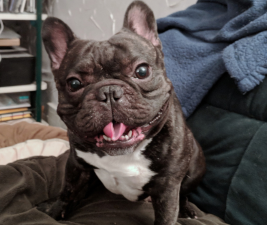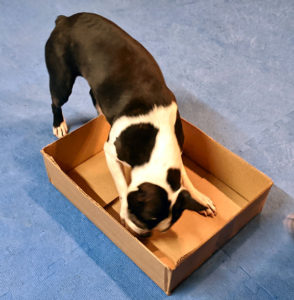What do you do when your dog won’t? Won’t come, won’t listen, won’t tolerate a new harness?
We were a bit sad this week. A customer had ordered a Choke-Free Shoulder Collar Harness for her dog. It was exactly what she needed – the dog has been diagnosed with collapsing trachea. But we got an email telling us she had to return the harness. While it’s perfect for her needs, her dog won’t get near it. Apparently the dog is afraid of the sound of hook-and-loop tape opening and closing.
We’re not sad because she’s returning the harness. While we want everyone to be delighted with everything they order from us, we understand that stuff happens. We’re sad because she didn’t ask what she could do to change her dog’s mind. This problem has an easy fix.
Get ahead of the issue
If you’re a little dog, the world can be an overwhelming place. That small dog’s one touchstone is you – the person who loves them and will always take care of them. That’s why you’re the perfect person to help your dog overcome these little fears.
In the case of the hook-and-loop tape, the problem could have been fixed in just a few days. All this person had to do was sit on the floor near her dog. With a bowl of yummy treats in her lap. Opening and closing the harness while tossing treats to the dog. As the dog figures out that nothing scary happens when they hear the sound, you can lessen the distance you toss the treat until the dog is coming right up to you.
The key to introducing anything new to your dog is to take it slow, start with some distance, and go at the dog’s pace. Even the scariest household monsters can become neutral objects. Good dog training doesn’t take long, uses no force, and should be a game you both look forward to playing.
Over the head freak-out
Just like some dogs are frightened of the sound of hook-and-loop tape, others are uncomfortable with harnesses that go over their heads. That one’s easy, too. Hold the harness in one hand and reach through the neck-hole to give the dog some treats. Start at the length of your arm. Gradually decrease how far you reach. In just a few two-minute practice sessions, the dog will probably be sticking his own head through the hole to get the treats. One of the exercises we teach in our puppy and beginner classes is having dogs stick their heads in plastic cones to get a treat. Is it a useful skill? Not at first. But if they ever have to wear the “cone of shame,” it won’t freak them out.
It’s the same procedure if your dog doesn’t like getting their paws touched to put on a step-in harness. Put the harness, open, on the floor and give the dog treats while they’re stepping on it. When they’ve mastered that, pull one side up one leg a little bit. Step-by-step, dogs can learn that things aren’t scary and they can cope.
Turn “my dog won’t” around
No one should betray their dog’s trust by forcing them into a situation they fear. But it’s never too late to introduce them to new things, or help them overcome current fears. All it takes is a gradual, incremental approach. And really yummy treats the dog adores.
One of the household monsters for many dogs is the vacuum cleaner. That one’s easy, too. Just turn it on in the next room so the dog adjusts to the noise. Gradually bring it closer. Or start with having it off, but in sight. Either approach works, if you give it time.
In all these cases it’s true that familiarity brings comfort. If they know what’s going on, they’ll be less afraid of it. Before you give up, before you dismiss, before you say “my dog won’t,” try to think of ways to turn it around. Your dog can, and will.
Enjoyed this post? Click here to sign up for the weekly newsletter and never miss another.












